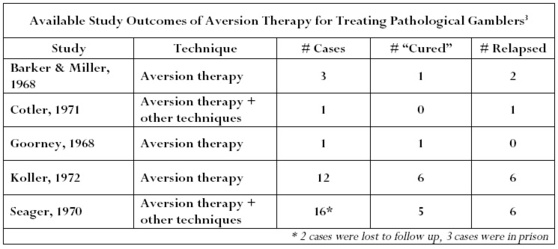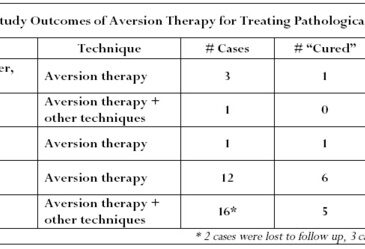Current trends and past experience influence the choice of treatment modality. In the late 1960s and early 1970s, aversion therapy was a popular treatment for pathological gamblers. The goal of aversion therapy was to suppress the targeted behavior (pathological gambling) by administering unpleasant sensations while the patient reenacted or re-experienced the problematic gambling behavior. For pathological gambling treatment, the unpleasant sensations were most often electrical shocks administered by either the therapist or the patients themselves. Some clinicians considered aversion therapy to be “remarkably effective,”* particularly if booster treatments were given to patients as a relapse prevention strategy. An advantage of aversion therapy was that it necessitated only a very short period of treatment, in contrast to, for example, long-term psychotherapy. Other clinical reports of aversion therapy for pathological gambling were less enthusiastic**. The hypothesis that encouraged the use of aversion therapy was that compulsive gambling behavior was a learned maladaptive behavior. Therefore, it must be “unlearned” according to the laws of learning theory. In 1997, clinicians no longer use aversion therapy to treat pathological gamblers. Many clinicians thought aversion treatment was cruel and unethical, considering that alternative treatments had similar or higher efficacy. However, nearly 30 years after the use of aversion therapy, the etiology of compulsive gambling remains largely unknown, which limits the assurance that current treatment modalities are the most beneficial treatments available. Future WAGER issues will examine cognitive-behavioral therapy, family therapy, and imaginal desensitization.
Available Study Outcomes of Aversion Therapy for Treating Pathological Gamblers***

Sources adapted from:
*Barker, J.C., & Miller, M. (1968). Aversion therapy for compulsive gambling. The Journal of Nervous and Mental Disease, 146(4), 285-302.
**Seager, C.P. (1970). Treatment of compulsive gamblers by electrical aversion. British Journal of Psychiatry, 117, 545-553.
***Lester, D. (1980). The treatment of compulsive gambling. The International Journal of the Addictions, 15(2), 201-206.
This public education project is funded, in part, by The Andrews Foundation.




